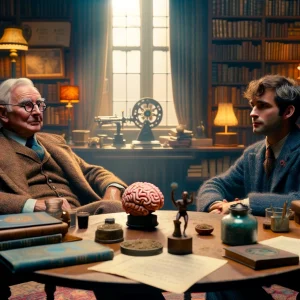 It’s important to note that at the time of the belladonna treatment the word “psychedelic” didn’t exist. It wouldn’t be coined until 1956, which is, perhaps coincidentally, the year that Bill Wilson first experimented with LSD. Researcher Dr. Humphrey Osmond, who was a pioneer in studies of alcoholism and lsd treatments, was seeking a name for this new class of hallucinogens and reached out to the writer, Aldous Huxley. Huxley wanted to name the class of drugs “”phanerothyme” from the Greek words “manifest” and “spirit” and sent Osmond a poem.
It’s important to note that at the time of the belladonna treatment the word “psychedelic” didn’t exist. It wouldn’t be coined until 1956, which is, perhaps coincidentally, the year that Bill Wilson first experimented with LSD. Researcher Dr. Humphrey Osmond, who was a pioneer in studies of alcoholism and lsd treatments, was seeking a name for this new class of hallucinogens and reached out to the writer, Aldous Huxley. Huxley wanted to name the class of drugs “”phanerothyme” from the Greek words “manifest” and “spirit” and sent Osmond a poem.
To make this mundane world sublime,
Take half a gram of phanerothyme
Osmond responded with a poem of his own…
To fathom Hell or soar angelic,
Just take a pinch of psychedelic
And so, the word was first used and has been ever since. We mention Bill Wilson’s first usage of LSD, but he was not the first person connected with Alcoholics Anonymous to experiment with LSD as a form of treatment or therapy. For that, we have to travel a bit earlier to Canada, which was at the forefront of LSD research at the time.
In 1953, Dr Humphrey Osmond, three years before he would coin the term ‘psychedelic’, and Dr. Abram Hoffer were having an evening conversation about alcoholics and delirium tremens. They were curious about the possible effects that LSD would have on alcoholics. At the time, they thought that perhaps since the psychedelic effects of LSD and delirium tremens experienced by alcoholics was similar, maybe artificially inducing these deliriums with LSD could have an effect on sobriety. Osmond later writes, “This idea at 4:00 A.M., seemed so bizarre that we laughed uproariously. But when our laughter subsided, the question seemed less comical and we formed our hypothesis or question: would a controlled LSD-produced delirium help alcoholics stay sober?” This is expanded upon in the book Pass it On.
“In 1954, Abram Hoffer and I, using LSD and mescaline [for] schizophrenia, conceived the idea that they represented something very similar to delirium tremens — that a good many people who really give up alcohol do so on basis of the fact that they’ve had an attack of D.T.’s and been impressed by them. We [thought] it might be a very good idea to give a person an ‘attack’ before he’d been completely destroyed. This was our original theory. We found, in fact, that this wasn’t quite how it worked. [It was] really not unlike Bill’s experience, which I later heard about — it gave a number of people pause for thought, not on the grounds of how terrifying it was, but how illuminating it was.” -Pass it On
And so, they chose two alcoholics, a male and a female, and administered 200mcg of LSD at the Saskatchewan Hospital in Weyborn. Of these two, the male stopped drinking for several months, whereas for the other, it appeared to have no effect on her drinking. Encouraged by these results, the doctors expanded their research to 24 alcoholics, but not any ordinary alcoholics. For this study, they sought out the hardest cases and reached out to other hospitals and agencies in the area. “We want your worst cases; we are not interested in mild cases that could recover through A.A. or through any other agency that you now have available.” Of the 24 in this group, they averaged uncontrollable drinking of about 12 years. Twenty had tried A.A. and failed. Twelve had been previously diagnosed as psychopathic. Eight had serious character or personality disorders, and the remaining four were borderline or actual psychotics. The results of the second study? Outcomes were tracked from 2 months up to 3 years. Of those in the study 6 reported either full abstinence or minimal drinking during that time, 6 had dramatically decreased their drinking, whereas the remaining 12 were unchanged in their drinking habits. This study led to another, this time with 60 “very difficult psychopathic alcoholics” and that after a five-year follow-up, it was reported by Dr. Hoffer at a 1959 Josiah Macy Conference on LSD”… half of them were no longer drinking. You will not believe it, and I would not have, either. The results are very impressive…”
Dr. Hoffer was not the only one working with LSD and alcoholics. A more controlled trial directly involving integration between AA and psychedelics took place in the same hospital, this time by Sven Jensen.
“Sven Jensen, a psychiatrist working in Weyburn, Saskatchewan, published the first controlled clinical trial of LSD in alcoholism in 1962. He developed a program based largely on the principles of AA. The treatment included weekly AA meetings. During 2 h of group psychotherapy, those who were not already familiar with the AA program were indoctrinated mainly by the other patient’s discussion. Toward the end of hospitalization, the patients were given LSD. The dosage (routinely 200μg) usually produced an intense reaction in a nonalcoholic person; however, alcoholics were relatively resistant. Patients preparing for the LSD experience were told that it would not prevent them from drinking but would rather make them understand why they drink and what they could do about it. Of 58 patients who experienced the full program, and were followed up for 6–18 months, 34 had remained totally abstinent since discharge or stayed abstinent following a short experimental bout immediately after discharge; 7 were definitely drinking less than before; 13 were unimproved; and 4 were lost to follow-up. Of 35 patients who received group therapy without LSD, 4 were abstinent, 4 were improved, 9 were unimproved, and 18 were lost to follow-up. Of 45 controls, consisting of patients admitted to the hospital during the same period who received individual treatment by other psychiatrists, 7 were abstinent, 3 improved, 12 unimproved, and 23 lost to follow-up. By a chi-squared test, significantly more of the alcoholics treated with LSD were abstinent or improved at the time of follow-up than of those who received group therapy alone or of the controls.” -The History of Psychedelics in Psychiatry, David E. Nichols & Hannes Walter
These results were astounding, with 58% of those who took LSD and integrating with AA staying sober for 6-18 months of follow-ups vs only 11% staying sober without LSD. In addition, an interesting side effect happened in this study: over 90% of the lsd group stayed in AA, whereas 50% of the non-LSD group dropped out of AA. Being informed of success rates like these are having an effect on Bill, who is passionate about helping those whom AA doesn’t seem to be working. The AA secretary, Nell Wing, reports
“There were alcoholics in the hospitals, of whom A. A. could touch and help only about five percent. The doctors started giving them a dose of LSD, so that the resistance would be broken down. And they had about 15 percent recoveries. This was all a scientific thing.” -Pass it On
During the summer of 1966, after thirteen years of research in this area, Dr. Hoffer published the statistics relating to the more than eight hundred hard-core alcoholics who had been treated in the Canadian LSD program.
“When psychedelic therapy is given to alcoholics using methods described in the literature about one-third will remain sober after the therapy is completed, and one-third will be benefited. If schizophrenics and malvarians are excluded from LSD therapy the results should be better by about 30 per cent. There are no published papers using psychedelic therapy which show it does not help about 50 per cent of the treated group….Our conclusion after 13 years of research is that properly used LSD therapy can convert a large number of alcoholics into sober members of society…. Even more important is the fact that this can be done very quickly and therefore very economically. Whereas with standard therapy one bed might be used to treat about 4 to 6 patients per year, with LSD one can easily treat up to 36 patients per bed per year.”
What’s interesting to note about Dr. Hoffers comments, is that he’s suggesting that treatment, which at the time was anywhere from 30-60 days on average for an alcoholic, can be shortened to 10 days with LSD therapy with increased outcomes over the longer stays. At the time of today’s writing, the average length of stay for an alcoholic or addict seeking treatment is anywhere from 30 to 90 days of residential followed by encouragement to attend 12-step meetings. Unfortunately, two years after Dr. Hoffer released his study, in 1968, LSD would be scheduled in the US as a schedule I drug, meaning it has no approved medical value. By 1971, the United Nations made a similar move and scheduled LSD. Any possible chance for a shorter term, higher success rate treatment program hinted at by Dr. Hoffer involving LSD was now officially over.




